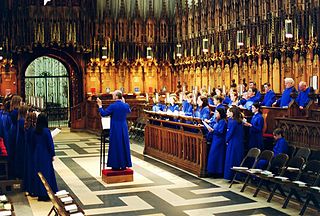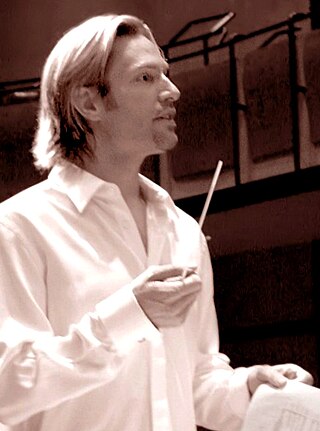
A choir is a musical ensemble of singers. Choral music, in turn, is the music written specifically for such an ensemble to perform. Choirs may perform music from the classical music repertoire, which spans from the medieval era to the present, or popular music repertoire. Most choirs are led by a conductor, who leads the performances with arm, hand, and facial gestures.

Norah Jones is an American singer-songwriter and pianist. She has won several awards for her music and, as of 2023, had sold more than 50 million records worldwide. Billboard named her the top jazz artist of the 2000s decade. She has won nine Grammy Awards and was ranked 60th on Billboard magazine's artists of the 2000s decade chart.
The 19th Annual Grammy Awards were held on February 19, 1977, and were broadcast live on American television (CBS). It was the seventh and final year Andy Williams hosted the telecast. The ceremony recognized accomplishments by musicians from the year 1976.

Eric Edward Whitacre is an American composer, conductor, and speaker best known for his choral music. In March 2016, he was appointed as Los Angeles Master Chorale's first artist-in-residence at the Walt Disney Concert Hall.

The Whitlams are an Australian Indie rock band formed in late 1992. The original line-up was Tim Freedman on keyboards and lead vocals, Andy Lewis on double bass and Stevie Plunder on guitar and lead vocals. Other than mainstay Freedman, the line-up has changed numerous times. From 2001 to 2022, he was joined by Warwick Hornby on bass guitar, Jak Housden on guitar and Terepai Richmond on drums – forming the band's longest-lasting and best-known line-up. Four of their studio albums have reached the ARIA Albums Chart top 20: Eternal Nightcap, Love This City, Torch the Moon and Little Cloud. Their highest charting singles are "Blow Up the Pokies" and "Fall for You" – both reached number 21. The group's single, "No Aphrodisiac" was listed at number one on the Triple J Hottest 100, 1997 by listeners of national radio station, Triple J. In January 1996 Stevie Plunder was found dead at the base of Wentworth Falls. Andy Lewis died in February 2000.

Raffaele Marcellino is an Australian composer.

Paradise Road is a 1997 Australian war film that tells the story of a group of English, American, Dutch and Australian women who are imprisoned by the Japanese in Sumatra during World War II. It was directed by Bruce Beresford and stars Glenn Close as Adrienne Pargiter,, Frances McDormand as the brash Dr. Verstak, Pauline Collins as missionary Margaret Drummond, Julianna Margulies as U.S. socialite Topsy Merritt, Jennifer Ehle as British doyenne and model Rosemary Leighton Jones, Cate Blanchett as Australian nurse Susan McCarthy and Elizabeth Spriggs as dowager Imogene Roberts.

Agnes Betty Jeffrey, OAM was an Australian writer who wrote about her Second World War nursing experiences in the book White Coolies.
San Diego Men's Chorus (SDMC) provided entertainment for San Diego, California, during the period of 1985 to 2009. A former member of the Gay & Lesbian Association of Choruses, SDMC performed some of the finest choral literature from a variety of genres. The Chorus offered numerous 'outreach performances' each season, and supported local LGBT organizations and HIV/AIDS organizations in the San Diego area.
Eugene Concert Choir is a choral masterworks organization in Eugene, Oregon, that consists of three performing ensembles: the 100-voice Eugene Concert Choir (ECC), the 36-voice chamber choir Eugene Vocal Arts (EVA), and the associated professional chamber orchestra Eugene Concert Orchestra.

A choral symphony is a musical composition for orchestra, choir, and sometimes solo vocalists that, in its internal workings and overall musical architecture, adheres broadly to symphonic musical form. The term "choral symphony" in this context was coined by Hector Berlioz when he described his Roméo et Juliette as such in his five-paragraph introduction to that work. The direct antecedent for the choral symphony is Ludwig van Beethoven's Ninth Symphony. Beethoven's Ninth incorporates part of the Ode an die Freude, a poem by Friedrich Schiller, with text sung by soloists and chorus in the last movement. It is the first example of a major composer's use of the human voice on the same level as instruments in a symphony.
There have been three choirs named The BBC Chorus in the history of the British Broadcasting Corporation.
- Today's BBC Symphony Chorus. Founded in 1928 as the BBC National Chorus, it changed its name to the BBC Chorus in 1932, before changing it again in 1935 to the BBC Choral Society.
- A 42-strong professional chorus developed in the 1930s. It would perform either alone or with the BBC Choral Society as a "choir within a choir". It was abolished in 1961 following changes to the BBC's choral structures.
- Today's BBC Singers. Founded in 1924 as a 16-strong BBC Wireless Chorus, and formally renamed The BBC Singers in 1935, it was expanded to 28 in 1961 and renamed The BBC Chorus as part of reforms to the BBC's choral set-up. It was then renamed The BBC Singers once more in 1972.
Margaret Dryburgh was an English teacher and missionary. Born in Sunderland, England, she later became a missionary in Singapore, where she was captured in the Second World War. The plight of Dryburgh and her fellow inmates such as Betty Jeffrey in a Japanese prisoner of war camp inspired the 1996 film Paradise Road. She wrote The Captives' Hymn while imprisoned.
Clare Maclean is a New Zealand composer.
The Peninsula Women's Chorus is a women's choir based at Palo Alto, California.

Antonie Hendrikus Colijn was a Dutch amateur mountaineer who in 1936 led the Carstensz Expedition, being the first to climb the Carstenszgebergte in New Guinea.
Eleanor Deanne Therese Alberga is a Jamaican contemporary music composer who lives and works in the United Kingdom. Her most recent compositions include two Violin Concertos, a Trumpet Concerto and a Symphony.
David Griffiths is a composer, baritone and convener of the Conservatorium of Music at the University of Waikato. Griffiths has gained national and international recognition as a composer, opera singer and recital soloist. His choral compositions are particularly popular in the United States of America and have, in recent years, been recorded by several choirs while many works have been included on various record labels including Naxos Records, Kiwi Pacific and Atoll.
Melodia Women's Choir NYC is a women's choir in Manhattan dedicated to exploring, creating and performing classical and contemporary music composed for women's voices. An ensemble of 30 singers, Melodia performs concerts in New York City, and supports emerging women composers through commissions and performances.
Norah Chambers was a Singaporean-born British chorale conductor and prisoner of war during World War II.









